BIOL122: Presentation on Pharmacological Management of Asthma, ACU
VerifiedAdded on 2022/10/08
|10
|974
|48
Presentation
AI Summary
This presentation, created for the BIOL122 course, offers a comprehensive overview of asthma, a chronic respiratory disease affecting millions. The presentation begins with a client introduction, detailing the patient's condition and medical history. It then delves into the definition and prevalence of asthma, followed by a detailed explanation of the pathophysiological changes that occur during an asthma attack, including bronchial smooth muscle contraction and increased mucus production. The presentation also covers the clinical manifestations of asthma, such as hypoxia and airway edema, and the pharmacological management of the condition. A specific focus is given to Salbutamol, a beta 2-agonist bronchodilator, detailing its mechanism of action, chemical formula, and both topical and systemic effects. Educational advice regarding dosage and precautions is also provided. The presentation is supported by relevant references to scientific literature.

ASTHMA- CONDITION OF A PATIENT
Paraphrase This Document
Need a fresh take? Get an instant paraphrase of this document with our AI Paraphraser
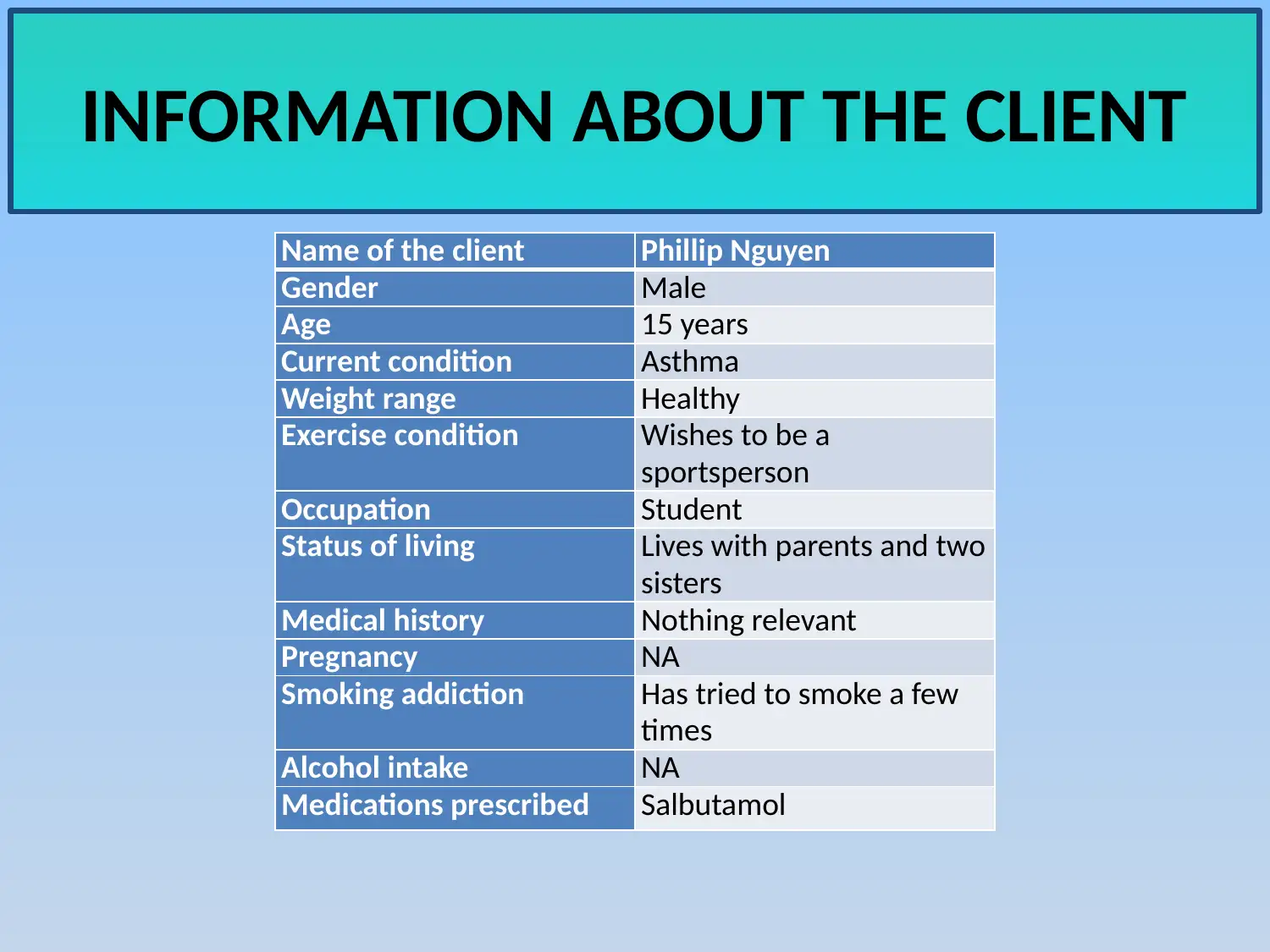
INFORMATION ABOUT THE CLIENT
Name of the client Phillip Nguyen
Gender Male
Age 15 years
Current condition Asthma
Weight range Healthy
Exercise condition Wishes to be a
sportsperson
Occupation Student
Status of living Lives with parents and two
sisters
Medical history Nothing relevant
Pregnancy NA
Smoking addiction Has tried to smoke a few
times
Alcohol intake NA
Medications prescribed Salbutamol
Name of the client Phillip Nguyen
Gender Male
Age 15 years
Current condition Asthma
Weight range Healthy
Exercise condition Wishes to be a
sportsperson
Occupation Student
Status of living Lives with parents and two
sisters
Medical history Nothing relevant
Pregnancy NA
Smoking addiction Has tried to smoke a few
times
Alcohol intake NA
Medications prescribed Salbutamol
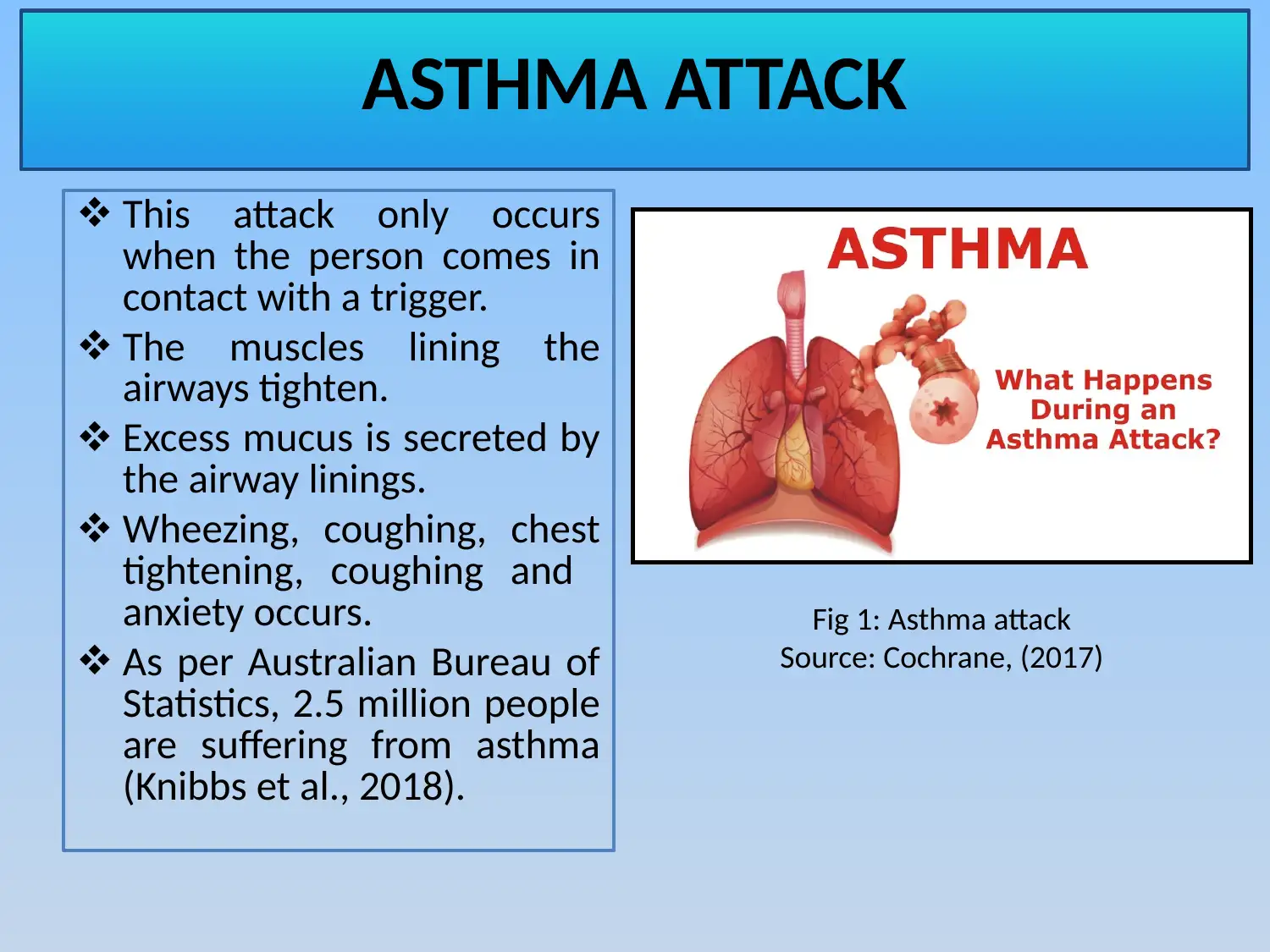
ASTHMA ATTACK
This attack only occurs
when the person comes in
contact with a trigger.
The muscles lining the
airways tighten.
Excess mucus is secreted by
the airway linings.
Wheezing, coughing, chest
tightening, coughing and
anxiety occurs.
As per Australian Bureau of
Statistics, 2.5 million people
are suffering from asthma
(Knibbs et al., 2018).
Fig 1: Asthma attack
Source: Cochrane, (2017)
This attack only occurs
when the person comes in
contact with a trigger.
The muscles lining the
airways tighten.
Excess mucus is secreted by
the airway linings.
Wheezing, coughing, chest
tightening, coughing and
anxiety occurs.
As per Australian Bureau of
Statistics, 2.5 million people
are suffering from asthma
(Knibbs et al., 2018).
Fig 1: Asthma attack
Source: Cochrane, (2017)
⊘ This is a preview!⊘
Do you want full access?
Subscribe today to unlock all pages.

Trusted by 1+ million students worldwide
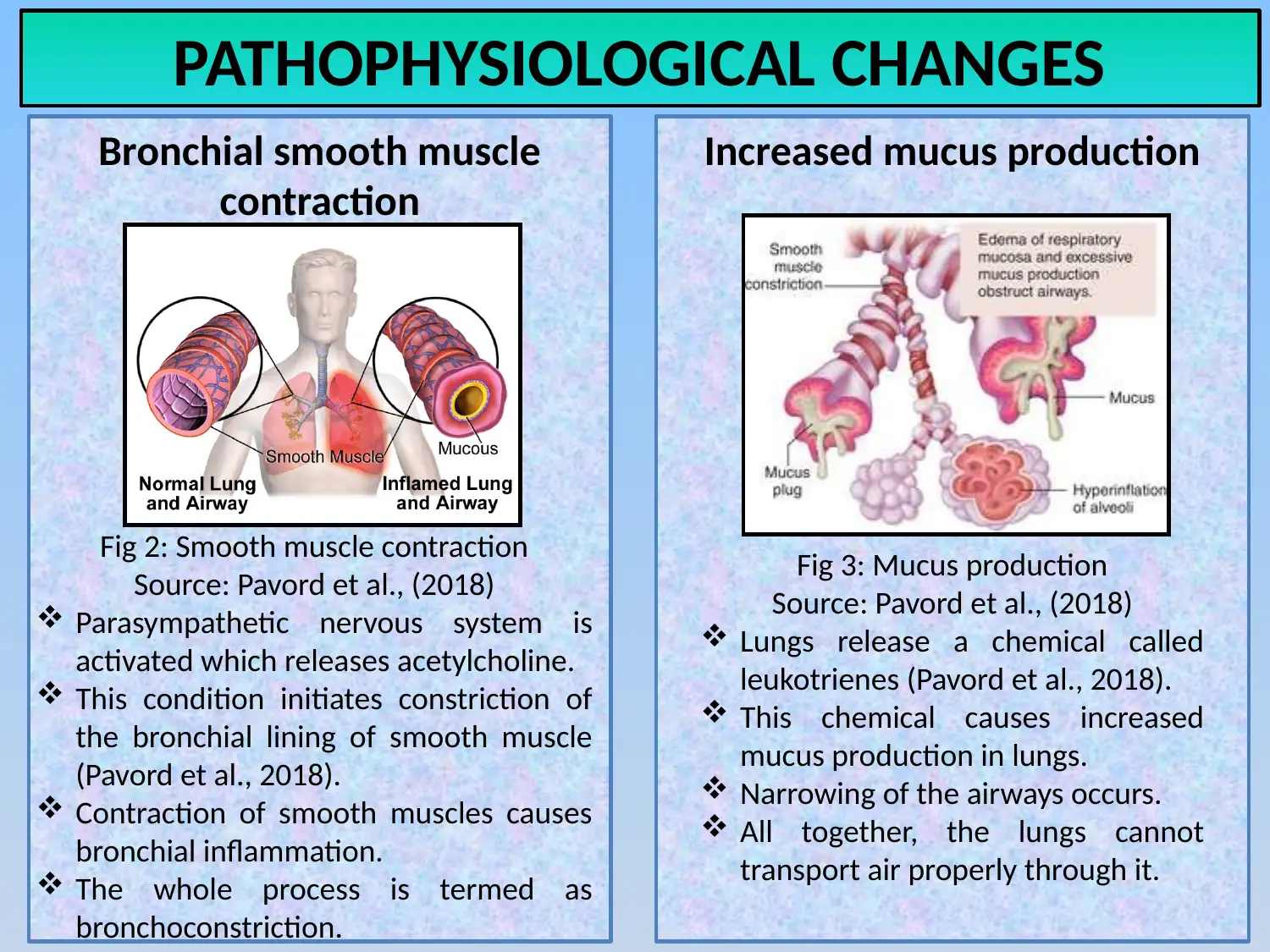
PATHOPHYSIOLOGICAL CHANGES
Bronchial smooth muscle
contraction
Increased mucus production
Fig 2: Smooth muscle contraction
Source: Pavord et al., (2018)
Parasympathetic nervous system is
activated which releases acetylcholine.
This condition initiates constriction of
the bronchial lining of smooth muscle
(Pavord et al., 2018).
Contraction of smooth muscles causes
bronchial inflammation.
The whole process is termed as
bronchoconstriction.
Fig 3: Mucus production
Source: Pavord et al., (2018)
Lungs release a chemical called
leukotrienes (Pavord et al., 2018).
This chemical causes increased
mucus production in lungs.
Narrowing of the airways occurs.
All together, the lungs cannot
transport air properly through it.
Bronchial smooth muscle
contraction
Increased mucus production
Fig 2: Smooth muscle contraction
Source: Pavord et al., (2018)
Parasympathetic nervous system is
activated which releases acetylcholine.
This condition initiates constriction of
the bronchial lining of smooth muscle
(Pavord et al., 2018).
Contraction of smooth muscles causes
bronchial inflammation.
The whole process is termed as
bronchoconstriction.
Fig 3: Mucus production
Source: Pavord et al., (2018)
Lungs release a chemical called
leukotrienes (Pavord et al., 2018).
This chemical causes increased
mucus production in lungs.
Narrowing of the airways occurs.
All together, the lungs cannot
transport air properly through it.
Paraphrase This Document
Need a fresh take? Get an instant paraphrase of this document with our AI Paraphraser
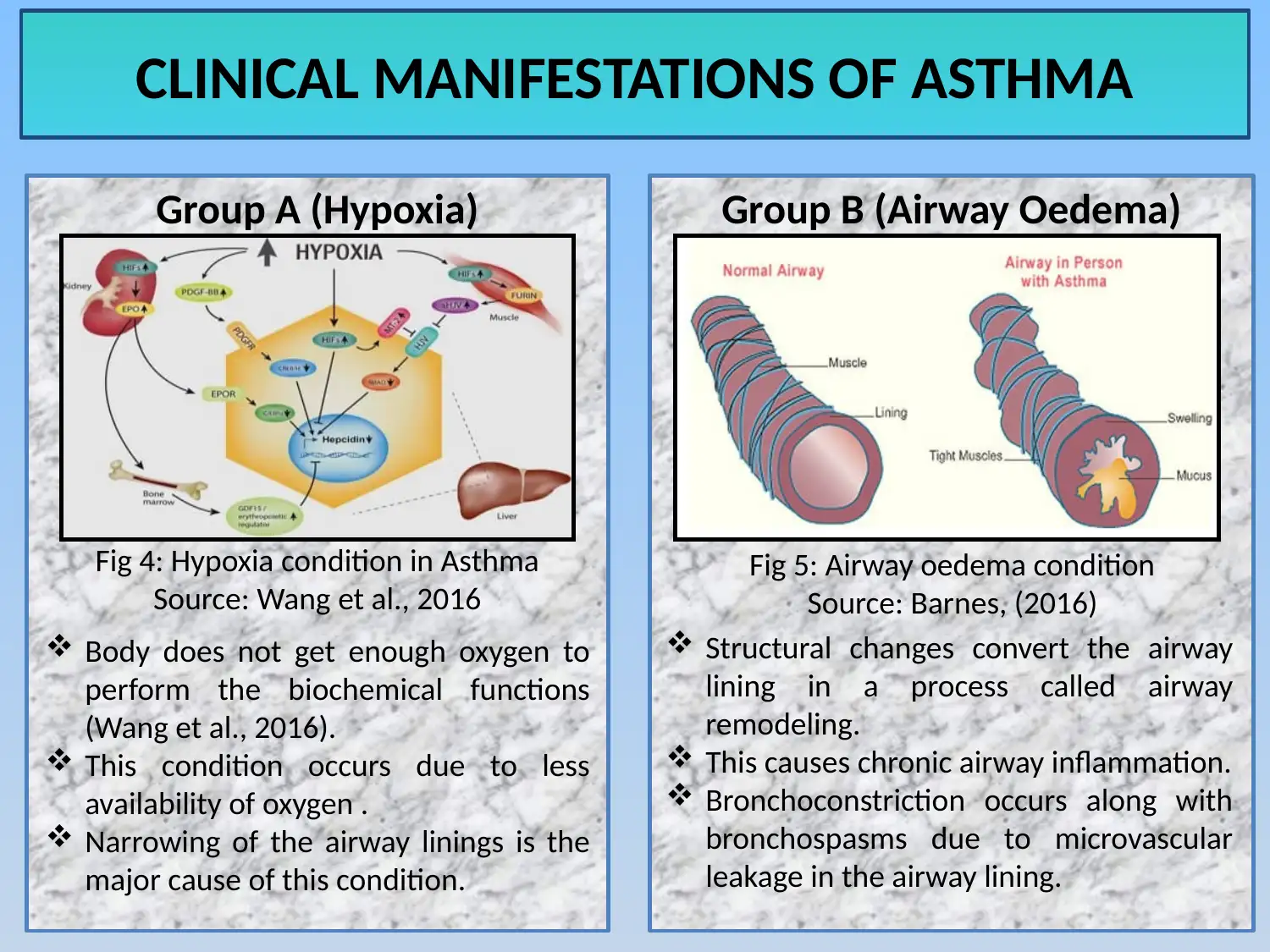
CLINICAL MANIFESTATIONS OF ASTHMA
Group A (Hypoxia) Group B (Airway Oedema)
Fig 4: Hypoxia condition in Asthma
Source: Wang et al., 2016
Body does not get enough oxygen to
perform the biochemical functions
(Wang et al., 2016).
This condition occurs due to less
availability of oxygen .
Narrowing of the airway linings is the
major cause of this condition.
Fig 5: Airway oedema condition
Source: Barnes, (2016)
Structural changes convert the airway
lining in a process called airway
remodeling.
This causes chronic airway inflammation.
Bronchoconstriction occurs along with
bronchospasms due to microvascular
leakage in the airway lining.
Group A (Hypoxia) Group B (Airway Oedema)
Fig 4: Hypoxia condition in Asthma
Source: Wang et al., 2016
Body does not get enough oxygen to
perform the biochemical functions
(Wang et al., 2016).
This condition occurs due to less
availability of oxygen .
Narrowing of the airway linings is the
major cause of this condition.
Fig 5: Airway oedema condition
Source: Barnes, (2016)
Structural changes convert the airway
lining in a process called airway
remodeling.
This causes chronic airway inflammation.
Bronchoconstriction occurs along with
bronchospasms due to microvascular
leakage in the airway lining.

SELECTION OF DRUG Salbutamol
Mechanism of action
Chemical formula of
Salbutamol:
Fig 6: Salbutamol
(Molecular formula)
Source: Jinno et al., (2018)
Salbutamol is a beta 2-
antagonist bronchodilator
which dilates bronchi during
air onstruction (Jinno et al.,
2018).
Also known an albuterol and
marketed by the name of
Ventolin.
Fig 7: Mechanism of action of salbutamol
Source: Beeh et al., (2013)
Salbutamol is a beta receptor which acts as
a G protein couple receptor.
By undergoing a signaling pathway
supported by adenylyl cyclase, it opens up
the potassium ion cahnnel and relieves
contraction.
Mechanism of action
Chemical formula of
Salbutamol:
Fig 6: Salbutamol
(Molecular formula)
Source: Jinno et al., (2018)
Salbutamol is a beta 2-
antagonist bronchodilator
which dilates bronchi during
air onstruction (Jinno et al.,
2018).
Also known an albuterol and
marketed by the name of
Ventolin.
Fig 7: Mechanism of action of salbutamol
Source: Beeh et al., (2013)
Salbutamol is a beta receptor which acts as
a G protein couple receptor.
By undergoing a signaling pathway
supported by adenylyl cyclase, it opens up
the potassium ion cahnnel and relieves
contraction.
⊘ This is a preview!⊘
Do you want full access?
Subscribe today to unlock all pages.

Trusted by 1+ million students worldwide
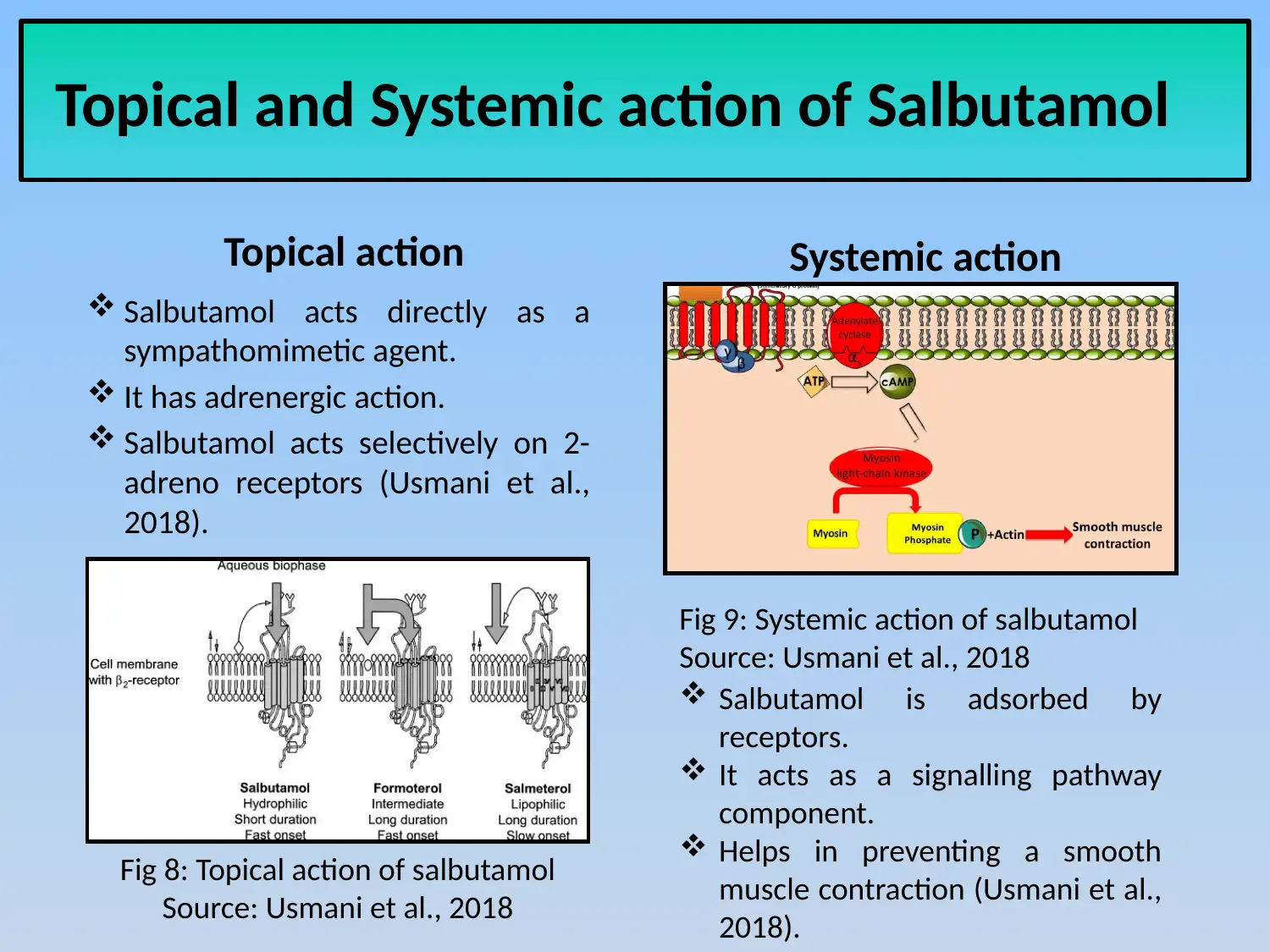
Topical and Systemic action of Salbutamol
Topical action
Salbutamol acts directly as a
sympathomimetic agent.
It has adrenergic action.
Salbutamol acts selectively on 2-
adreno receptors (Usmani et al.,
2018).
Systemic action
Fig 8: Topical action of salbutamol
Source: Usmani et al., 2018
Fig 9: Systemic action of salbutamol
Source: Usmani et al., 2018
Salbutamol is adsorbed by
receptors.
It acts as a signalling pathway
component.
Helps in preventing a smooth
muscle contraction (Usmani et al.,
2018).
Topical action
Salbutamol acts directly as a
sympathomimetic agent.
It has adrenergic action.
Salbutamol acts selectively on 2-
adreno receptors (Usmani et al.,
2018).
Systemic action
Fig 8: Topical action of salbutamol
Source: Usmani et al., 2018
Fig 9: Systemic action of salbutamol
Source: Usmani et al., 2018
Salbutamol is adsorbed by
receptors.
It acts as a signalling pathway
component.
Helps in preventing a smooth
muscle contraction (Usmani et al.,
2018).
Paraphrase This Document
Need a fresh take? Get an instant paraphrase of this document with our AI Paraphraser
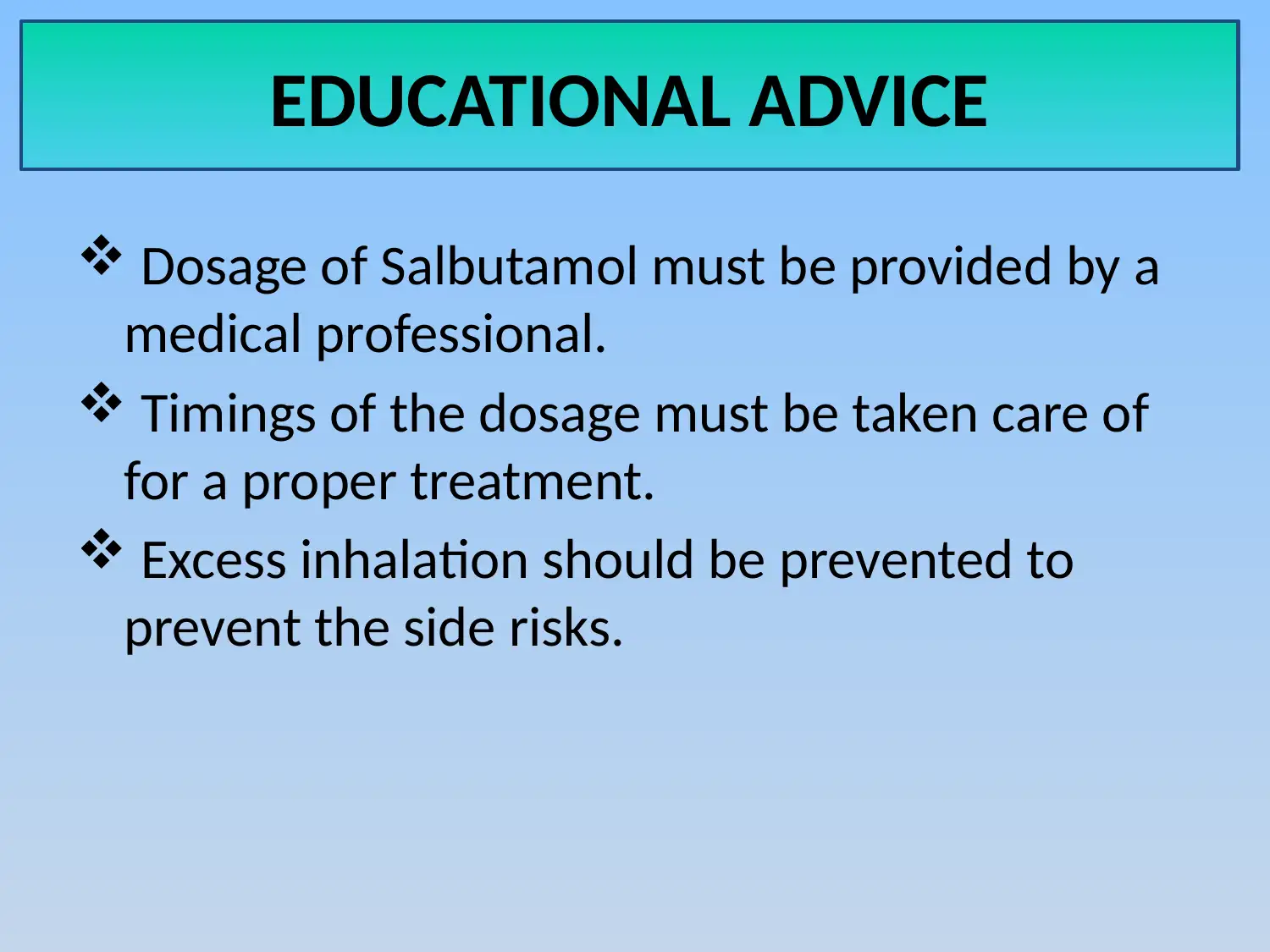
EDUCATIONAL ADVICE
Dosage of Salbutamol must be provided by a
medical professional.
Timings of the dosage must be taken care of
for a proper treatment.
Excess inhalation should be prevented to
prevent the side risks.
Dosage of Salbutamol must be provided by a
medical professional.
Timings of the dosage must be taken care of
for a proper treatment.
Excess inhalation should be prevented to
prevent the side risks.
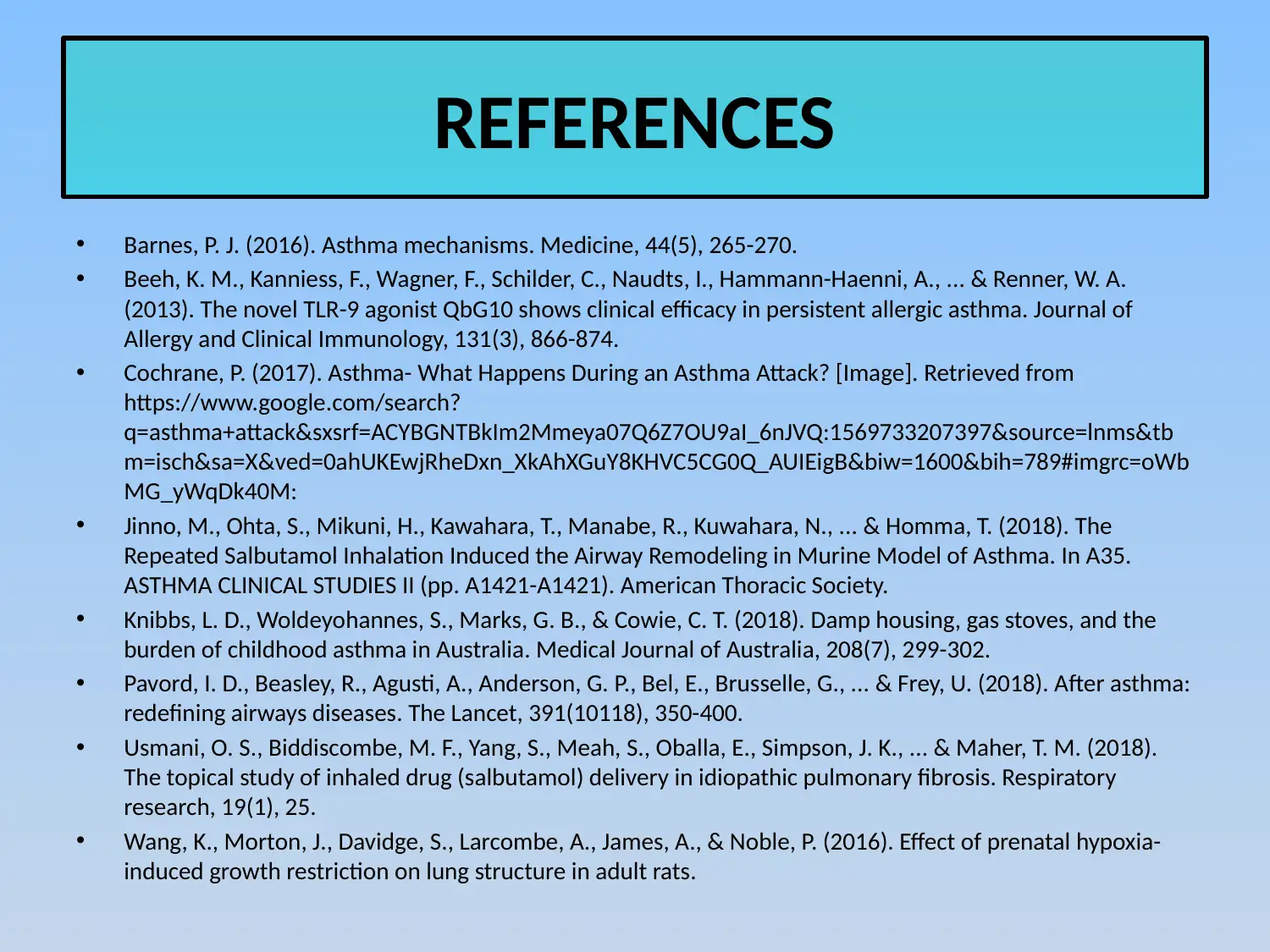
REFERENCES
• Barnes, P. J. (2016). Asthma mechanisms. Medicine, 44(5), 265-270.
• Beeh, K. M., Kanniess, F., Wagner, F., Schilder, C., Naudts, I., Hammann-Haenni, A., ... & Renner, W. A.
(2013). The novel TLR-9 agonist QbG10 shows clinical efficacy in persistent allergic asthma. Journal of
Allergy and Clinical Immunology, 131(3), 866-874.
• Cochrane, P. (2017). Asthma- What Happens During an Asthma Attack? [Image]. Retrieved from
https://www.google.com/search?
q=asthma+attack&sxsrf=ACYBGNTBkIm2Mmeya07Q6Z7OU9aI_6nJVQ:1569733207397&source=lnms&tb
m=isch&sa=X&ved=0ahUKEwjRheDxn_XkAhXGuY8KHVC5CG0Q_AUIEigB&biw=1600&bih=789#imgrc=oWb
MG_yWqDk40M:
• Jinno, M., Ohta, S., Mikuni, H., Kawahara, T., Manabe, R., Kuwahara, N., ... & Homma, T. (2018). The
Repeated Salbutamol Inhalation Induced the Airway Remodeling in Murine Model of Asthma. In A35.
ASTHMA CLINICAL STUDIES II (pp. A1421-A1421). American Thoracic Society.
• Knibbs, L. D., Woldeyohannes, S., Marks, G. B., & Cowie, C. T. (2018). Damp housing, gas stoves, and the
burden of childhood asthma in Australia. Medical Journal of Australia, 208(7), 299-302.
• Pavord, I. D., Beasley, R., Agusti, A., Anderson, G. P., Bel, E., Brusselle, G., ... & Frey, U. (2018). After asthma:
redefining airways diseases. The Lancet, 391(10118), 350-400.
• Usmani, O. S., Biddiscombe, M. F., Yang, S., Meah, S., Oballa, E., Simpson, J. K., ... & Maher, T. M. (2018).
The topical study of inhaled drug (salbutamol) delivery in idiopathic pulmonary fibrosis. Respiratory
research, 19(1), 25.
• Wang, K., Morton, J., Davidge, S., Larcombe, A., James, A., & Noble, P. (2016). Effect of prenatal hypoxia-
induced growth restriction on lung structure in adult rats.
• Barnes, P. J. (2016). Asthma mechanisms. Medicine, 44(5), 265-270.
• Beeh, K. M., Kanniess, F., Wagner, F., Schilder, C., Naudts, I., Hammann-Haenni, A., ... & Renner, W. A.
(2013). The novel TLR-9 agonist QbG10 shows clinical efficacy in persistent allergic asthma. Journal of
Allergy and Clinical Immunology, 131(3), 866-874.
• Cochrane, P. (2017). Asthma- What Happens During an Asthma Attack? [Image]. Retrieved from
https://www.google.com/search?
q=asthma+attack&sxsrf=ACYBGNTBkIm2Mmeya07Q6Z7OU9aI_6nJVQ:1569733207397&source=lnms&tb
m=isch&sa=X&ved=0ahUKEwjRheDxn_XkAhXGuY8KHVC5CG0Q_AUIEigB&biw=1600&bih=789#imgrc=oWb
MG_yWqDk40M:
• Jinno, M., Ohta, S., Mikuni, H., Kawahara, T., Manabe, R., Kuwahara, N., ... & Homma, T. (2018). The
Repeated Salbutamol Inhalation Induced the Airway Remodeling in Murine Model of Asthma. In A35.
ASTHMA CLINICAL STUDIES II (pp. A1421-A1421). American Thoracic Society.
• Knibbs, L. D., Woldeyohannes, S., Marks, G. B., & Cowie, C. T. (2018). Damp housing, gas stoves, and the
burden of childhood asthma in Australia. Medical Journal of Australia, 208(7), 299-302.
• Pavord, I. D., Beasley, R., Agusti, A., Anderson, G. P., Bel, E., Brusselle, G., ... & Frey, U. (2018). After asthma:
redefining airways diseases. The Lancet, 391(10118), 350-400.
• Usmani, O. S., Biddiscombe, M. F., Yang, S., Meah, S., Oballa, E., Simpson, J. K., ... & Maher, T. M. (2018).
The topical study of inhaled drug (salbutamol) delivery in idiopathic pulmonary fibrosis. Respiratory
research, 19(1), 25.
• Wang, K., Morton, J., Davidge, S., Larcombe, A., James, A., & Noble, P. (2016). Effect of prenatal hypoxia-
induced growth restriction on lung structure in adult rats.
⊘ This is a preview!⊘
Do you want full access?
Subscribe today to unlock all pages.

Trusted by 1+ million students worldwide

THANK YOU
1 out of 10
Related Documents
Your All-in-One AI-Powered Toolkit for Academic Success.
+13062052269
info@desklib.com
Available 24*7 on WhatsApp / Email
![[object Object]](/_next/static/media/star-bottom.7253800d.svg)
Unlock your academic potential
Copyright © 2020–2025 A2Z Services. All Rights Reserved. Developed and managed by ZUCOL.





